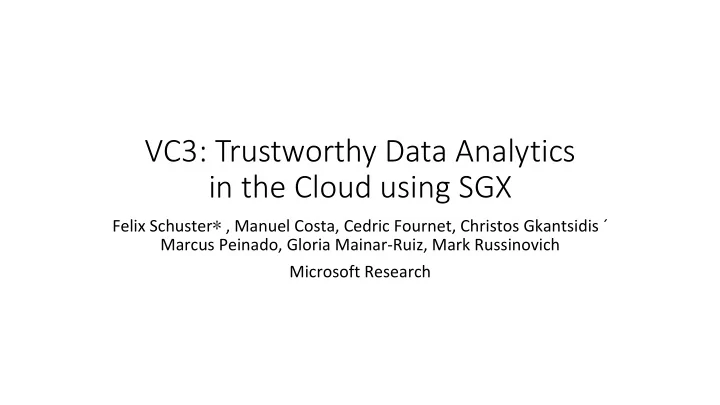

VC3: Trustworthy Data Analytics in the Cloud using SGX Felix Schuster ∗ , Manuel Costa, Cedric Fournet, Christos Gkantsidis ´ Marcus Peinado, Gloria Mainar-Ruiz, Mark Russinovich Microsoft Research
Outline • Introduction • Background • Design Overview • Job Deployment • Job Execution and Verification • Regional Self-Integrity • Implementation • Evaluation • Related Work • Conclusion
Introduction • Cloud providers allow computers into data centers and make them available on-demand • Users have the ability to rent out computing capacity to run large- scale distributed computations based on frameworks like MapReduce • A major concern for users is the ability to trust the cloud provider with their code and data
Introduction (cont’d) • Concerns: • Single malicious insider with admin access in the cloud can leak or manipulate sensitive user data • External attackers attempt to access data (e.g. exploit vulnerabilities in an OS) • External attackers may tamper with users’ computations • Cloud User Expectations • Confidentiality and integrity for both code and data • Verifiability of execution of the code over data • Multiparty computation techniques may address these demands using Fully Homomorphic Encryption (FHE) • However, FHE is not efficient for most computations
Introduction (cont’d) • Verifiable Confidential Cloud Computing (VC3) • A system that allows users to run MapReduce computations in the cloud while keeping their code and data secret and ensuring correctness and completeness of their results • Threat Model • Powerful attackers that may have the ability to control the whole cloud providers software and hardware infrastructure • Tools Used • Trusted SGX processors • Ran an unmodified Hadoop
Introduction (cont’d) • Challenges: • Partition the system into trusted and untrusted parts to minimize its TCB • Guarantee integrity for the whole distributed computation • Protect the code running in the isolated memory regions from attacks due to unsafe memory accesses
Background • MapReduce • A popular programming model for processing large data sets: users write map and reduce functions, and execution of functions is automatically parallelized and distributed • Intel SGX • Set of x86-64 ISA extensions • Sets up protected execution environments (called enclaves) without requiring trust in anything but processor and code put in the enclaves
Adversary Model • Aware of external attackers that may try to control the entire software stack in a cloud provider’s infrastructure, including the hypervisor and OS • Assume the attacker is unable to physically open and manipulate tat least the SGX-enabled processor packages
Design Overview • Goal: Maintain confidentiality and integrity of code and data • Researchers designed VC3 to achieve good performance and keep large software components out of the TCB • VC3 allows users to implement MapReduce jobs by writing, testing, and debugging map and reduce functions • When map and reduce functions are ready for production, users compile and encrypt the code, and obtain a private enclave E- code • In the cloud, enclaves containing E- and E+ are initialized and l
Design Overview
Job Deployment • After the deployment of a users code to the cloud, cryptographic protocols are exchanged and the actual MapReduce job execution starts • Cloud Attestation • SGX remote attestation for enclaves is achieved through quotes issued by QE • Threat model excludes physical attacks, to defend against such attacks, they used an additional Cloud QE • Cloud QE was created by the cloud provider when a new SGX-enabled system is created
Job Deployment • Key Exchange • To execute MapReduce jobs, enclaves need to get keys to decrypt the results • Researchers created their own key exchange protocol which is designed to implement a conventional MapReduce job that works with Hadoop
Job Execution & Verification • Key exchanges and encryption code will help code and data be safe from attacks • Researchers have to encrypt data in a MapReduce job and this capability needs to work within Hadoop
Region Self-Integrity • Final aspect of design is to enforce a region of self-integrity for user code loaded into enclaves • Establish efficient communication channels • Leads to a broaden attack surface on enclaves • Two solutions: • Region-write-integrity • Region-read-write-integrity
Discussion • Several Attack Scenarios: • Information Leakage • One basic principle of MapReduce is that key-value pairs with the same key need to be processed by the same reducer • A network attacker can count the number of pairs being delivered and change the pairs • Replay Attacks • Attackers can try to fully or partially replay a past MapReduce job
Implementation • VC3 was implemented using C++ for Windows 64-bit and HDInsight distribution of Hadoop • SGX Emulation • Researchers implemented VC3 in an SGX Emulator which was successful • As well, created their own emulator, however the emulator does not provide security guarantees
Evaluation • Researchers chose a mix of real-world applications and benchmarks to evaluate the VC3 system • The following table shows the applications used to evaluate VC3
Conclusion • VC3 created as an approach for the verifiable and confidential execution of MapReduce jobs in untrusted cloud environments • VC3 is able to be successful implemented and has strong security guarantees • VC3 is able to achieve secure cloud computations
Recommend
More recommend